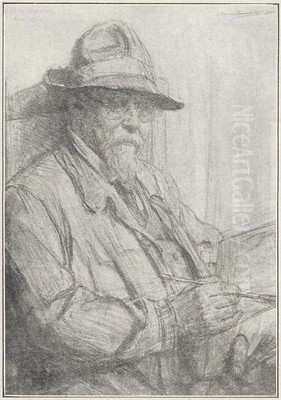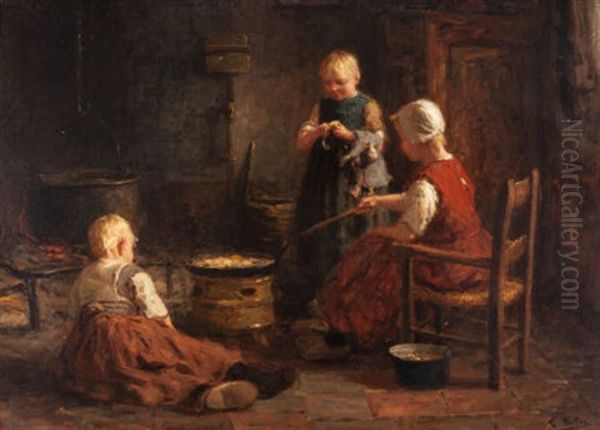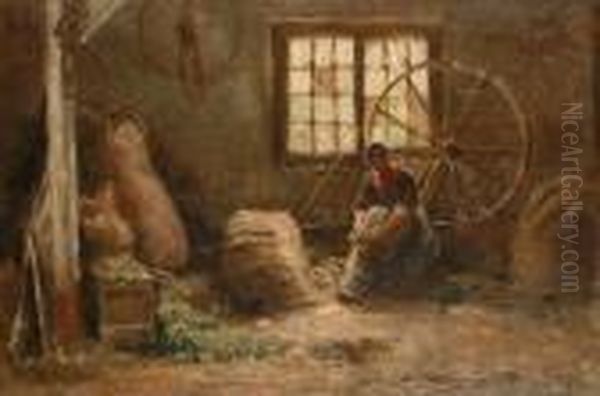
Evert Pieters (1856-1932) stands as a notable figure in the landscape of late 19th and early 20th-century European art. A Dutch painter by birth, much of his formative artistic development and early career unfolded in Belgium, creating a unique blend of influences in his work. Renowned primarily for his evocative landscapes, intimate interior scenes, and sensitive portrayals of everyday life, Pieters carved a niche for himself through his masterful handling of light and colour, creating works that continue to resonate with warmth and quiet dignity. His journey from humble beginnings to recognized artist reflects both personal determination and the shifting artistic currents of his time.
From Humble Beginnings to Artistic Awakening
Born in Amsterdam in 1856 into a family of modest means, Evert Pieters' early life offered few indications of a future in the arts. Financial constraints were a significant reality for the family. However, a burgeoning interest in drawing and painting emerged during his youth. Seeking opportunities beyond his immediate surroundings, the young Pieters made a pivotal decision to move to Antwerp, Belgium. This city, with its rich artistic heritage and vibrant contemporary scene, would prove crucial in shaping his path.
Initially, Pieters enrolled to study decorative painting. This practical training likely honed his skills in composition and colour application, providing a foundation, even if his ultimate calling lay elsewhere. Life wasn't easy, and he reportedly supported himself through various jobs, including painting decorations, while pursuing his artistic education. It was in Antwerp that his innate talent for fine art began to truly surface and attract attention.
Mentorship and Finding a Path
A significant turning point in Pieters' artistic formation came through his encounter with the established Belgian landscape painter, Theodoor Verstraete (1851-1907). Verstraete, a respected figure associated with Belgian Realism and known for his atmospheric landscapes, recognized the potential in the young Dutch artist. He took Pieters under his wing, becoming not just a teacher but a mentor. This relationship was instrumental.

Under Verstraete's guidance, Pieters began to shift his focus from decorative work towards easel painting, particularly landscapes. Verstraete encouraged him to study at the prestigious Royal Academy of Fine Arts in Antwerp, further solidifying his formal training. Perhaps just as importantly, Verstraete introduced Pieters to the practice of painting en plein air – working directly from nature outdoors. They reportedly spent time painting together in the countryside around Antwerp, allowing Pieters to develop his observational skills and his ability to capture the nuances of natural light and atmosphere, hallmarks that would define his later style.
Breakthrough and Recognition
While studying and honing his craft, Pieters also needed to earn a living. He continued to paint various subjects, including interior scenes and still lifes, which found a market and helped sustain him. However, his ambition increasingly lay in establishing himself as a serious artist through landscape and genre painting. The year 1883 marked a significant breakthrough.
Pieters submitted a painting titled Rusttijd van houthakkers (translated as Woodcutters Resting or Rest Time for the Woodcutters) to the World Exhibition held in Antwerp that year. The work depicted labourers taking a break, a theme rooted in the Realist tradition of portraying everyday working life. The painting was well-received, garnering positive attention and signalling Pieters' arrival on the Belgian art scene. This success provided crucial validation and likely emboldened him to pursue his artistic vision with greater confidence.
Further recognition followed. In 1885, his painting Flemish Wheatfield (or Korenveld in Vlaanderen) achieved notable success, reportedly winning awards at Salons in both Paris and Belgium. These accolades were significant, as the Paris Salon was the epicentre of the art world, and success there could launch an international career. This period cemented Pieters' reputation as a skilled painter capable of capturing the beauty of the rural landscape with sensitivity and technical proficiency.
The Signature Style: Light, Colour, and Everyday Scenes
Evert Pieters developed a distinct artistic style characterized by several key elements. His subject matter predominantly revolved around rural landscapes, particularly those of Flanders and later the Dutch Gooi region, and intimate interior scenes, often featuring women and children engaged in quiet domestic activities. He possessed a remarkable ability to render light, whether it was the bright sunlight illuminating a field, the dappled light filtering through trees, or the soft glow entering a room through a window.

His handling of light was often the defining feature of his compositions. He masterfully captured its effects on surfaces, its ability to create mood, and its interplay with shadow. This focus on light effects connects him to broader trends like Impressionism and Luminism, although his style remained rooted in a more Realist tradition, with careful drawing and a clear rendering of forms. Unlike the sometimes starker realism of the early Hague School painters like Jozef Israëls, Pieters often imbued his scenes with a warmer, more optimistic atmosphere.
His colour palette evolved but often featured soft, harmonious tones. Some observers noted a "southern palette," suggesting perhaps brighter or clearer colours compared to the more tonal, greyed palettes associated with some of his Dutch contemporaries of the Hague School, such as Anton Mauve or Hendrik Willem Mesdag. This might reflect his Belgian training or his personal inclination towards capturing the vibrancy of light. His brushwork, while capable of descriptive detail, often retained a certain looseness, contributing to the overall sense of atmosphere and life in his paintings.
Chronicler of Rural and Domestic Life
Thematically, Pieters was drawn to the depiction of simple, everyday life. His landscapes often featured agricultural activities – harvesting wheat, working the fields – or showed the quiet integration of farmhouses and figures within the natural environment. These works celebrate the pastoral ideal and the dignity of rural labour, common themes in 19th-century Realism, echoing the work of artists like the French painter Jean-François Millet, though Pieters' interpretations were generally less monumental and more intimate.
His interior scenes are particularly noteworthy for their warmth and tranquility. He frequently painted women engaged in domestic tasks like sewing, peeling vegetables, or caring for children. Works like A Woman Sewing in a Sunlit Room (c. 1900) exemplify this genre. These paintings often emphasize the play of light within the confined space, highlighting textures and creating a peaceful, contemplative mood. The figures are portrayed with empathy and respect, capturing moments of quiet concentration or familial tenderness. His painting My Wife Marie (1897) suggests a personal connection to these domestic themes.
Children also feature regularly in his work, often depicted playing or assisting with simple chores, reflecting an idealized view of childhood innocence and integration into the family unit. Through these recurring themes, Pieters presented a vision of life characterized by simplicity, hard work, domestic harmony, and a close connection to nature.
A Life of Movement: Travels and the Gooi Influence
Sources suggest Evert Pieters led a somewhat peripatetic life, particularly in his earlier career. Described by some as having a "bohemian" lifestyle, he travelled, seeking inspiration and perhaps commissions. His journeys reportedly took him to various parts of Europe, including France and Italy, although specific details of these trips and their direct impact on his work are not always well-documented. Such travels would have exposed him to different landscapes, artistic traditions, and contemporary art movements, subtly enriching his perspective.
After achieving success in Belgium and exhibiting internationally, Pieters eventually returned to his native Netherlands. He spent time in Katwijk, a coastal village popular with artists, and Volendam, known for its picturesque traditional culture, which also attracted painters like H.W. Mesdag. Later, he settled in the Gooi region, specifically in Blaricum, near Laren. This area had become a significant artists' colony, attracting prominent members of the Hague School and Amsterdam Impressionism, including Anton Mauve, Jozef Israëls, Albert Neuhuys, and later figures associated with the Laren School.
The sunny farmhouses, heathlands, and rural character of the Gooi provided Pieters with ample subject matter that resonated with his established interests. His time there allowed him to engage with the Dutch artistic community while continuing to develop his signature style. The light in the Gooi region, often described as clear and bright, likely further influenced his luminous depictions of landscapes and interiors during this later phase of his career.
Navigating the Art World: Contemporaries and Connections
Evert Pieters' career spanned a period of significant artistic activity in both Belgium and the Netherlands. His primary documented connection was with his mentor, Theodoor Verstraete, whose influence was foundational. While Pieters exhibited alongside many prominent artists of his day in Salons and exhibitions, specific records of close collaborations or joint projects with other painters are scarce.
There is also no clear evidence that Pieters formally joined major artistic societies or groups, such as the Pulchri Studio in The Hague or Arti et Amicitiae in Amsterdam, although he certainly moved within these artistic circles. His individual success seems to have been built more on the merit of his work exhibited publicly and sold through dealers, rather than through strong affiliations with specific movements or associations.
His work can be contextualized alongside his contemporaries. In Belgium, his focus on light might be loosely compared to the Luminist tendencies of painters like Emile Claus, though Pieters generally maintained a more solid, realistic structure. In the Netherlands, his rural themes connect him to the Hague School (Jozef Israëls, Anton Mauve), but his brighter palette and often more optimistic mood offer a contrast to the frequently somber tones of that school. He differed significantly from the urban dynamism captured by the Amsterdam Impressionists like George Hendrik Breitner and Isaac Israëls. He remained somewhat distinct, blending Belgian influences with Dutch sensibilities. Other notable Dutch artists active during his lifetime include figures like Willem Witsen and Floris Verster, each pursuing their own distinct paths within the rich tapestry of Dutch art. Even the globally renowned Vincent van Gogh was a contemporary, though their artistic trajectories and styles were vastly different.
Masterworks: A Closer Look
Several paintings stand out as representative of Evert Pieters' oeuvre and artistic concerns. Woodcutters Resting (1883), his early success, likely depicted a group of labourers in a woodland setting, capturing a moment of respite. Its positive reception at the Antwerp World Exhibition highlighted his skill in figure painting and composition within a landscape context, aligning with Realist interests in portraying working life.
Flemish Wheatfield (1885), awarded in Paris and Belgium, would have showcased his ability to render the expansive, sunlit landscapes of Flanders. Such works often emphasized the golden hues of ripe wheat under a broad sky, perhaps with figures engaged in harvesting, celebrating the bounty and beauty of the agricultural landscape. The awards suggest a high degree of technical accomplishment and appealing atmospheric quality.
A Woman Sewing in a Sunlit Room (c. 1900) is a prime example of his popular interior scenes. Typically, such a work would feature a solitary female figure absorbed in her task, positioned near a window. The focus would be on the interplay of light and shadow within the room, illuminating the figure, the textures of fabric, and simple furnishings, creating an atmosphere of quiet domesticity and concentration. These works were admired for their intimacy and masterful light effects, reminiscent in spirit, if not style, of the Dutch Golden Age masters like Johannes Vermeer.
My Wife Marie (1897) offers a more personal glimpse, presumably a portrait or genre scene featuring his wife. This title suggests the importance of family and domestic life not just as artistic themes, but in his personal experience. The painting likely shares the characteristics of his other interiors – sensitivity, warmth, and a focus on light. Other works mentioned in auction records, like Old Woman by the Fireplace (1908), Dame in boudoir, and Jong geleerd, oud gedaan (roughly translating to 'learned young is done old', suggesting a scene of a child learning a craft), further illustrate his consistent interest in genre subjects and domestic interiors throughout his career.
Collectors, Museums, and Enduring Appeal
Evert Pieters' work found favour with collectors during his lifetime and continues to be appreciated. His appealing subject matter – peaceful landscapes and charming domestic scenes – combined with his technical skill, particularly his handling of light, made his paintings desirable. The mention of collectors like William Angus and Anna Williams, who reportedly acquired multiple works, indicates a dedicated following.
His paintings have also found their way into public collections, ensuring his legacy endures. Notably, works by Evert Pieters are held in the Rijksmuseum in Amsterdam, the national museum of the Netherlands, signifying his recognition within the canon of Dutch art. The Singer Laren museum, located in the Gooi region where Pieters worked, also holds examples of his paintings, appropriately reflecting his connection to the Laren School artists' colony. The Stedelijk Museum Alkmaar is another Dutch institution reported to have his work. While some initial sources mentioned other international museums, these specific holdings are well-attested and confirm his status within Dutch museum collections.
The enduring appeal of Pieters' work lies in its accessibility, warmth, and technical finesse. He captured aspects of life and nature with a gentle optimism and a sensitivity to the beauty of light that resonates across time. His paintings offer moments of tranquility and connection to a simpler, perhaps idealized, past.
Evert Pieters on the Market: Auction Insights
The market for Evert Pieters' work remains active, reflecting continued collector interest. Auction records provide insights into the valuation and types of works that appear. Oil paintings, particularly his characteristic interior scenes and landscapes, generally command higher prices. For instance, the oil painting Old Woman by the Fireplace (1908), a substantial work measuring 95.1 x 75 cm, carried a pre-sale estimate of €4,000 to €6,000 in a recent auction, indicating significant value placed on his major works. Its provenance, including exhibition history and private collection status, likely contributed to this estimate.
Other oil paintings, such as Dame in boudoir and Jong geleerd, oud gedaan, have appeared with estimates in the range of €2,000 to €4,000, suggesting a consistent market for his genre subjects. A smaller, early 20th-century Kitchen Scene (71 x 59 cm) had a more modest estimate of £400 to £600, perhaps reflecting condition, period, or specific subject matter appeal.
Interestingly, his works in other media also appear. An etching titled Waiting for Supper (7.5" x 9.5") achieved a sale price of £1,863 (approximately €2,200 or ,350 at typical exchange rates) in late 2024. This strong price for a print suggests that even his graphic work is sought after, possibly due to the appealing domestic subject matter mirroring his popular paintings. Overall, the auction data indicates a stable market for Pieters, with his well-executed oil paintings of favoured themes achieving respectable prices, confirming his established position among collectors of Dutch and Belgian art of the period.
Evert Pieters: An Enduring Legacy
Evert Pieters occupies a unique position in art history, bridging the artistic worlds of Belgium and the Netherlands. His training under Theodoor Verstraete in Antwerp imbued him with aspects of Belgian Realism and an appreciation for atmospheric landscape painting, while his Dutch roots and later life in the Gooi region connected him to the ongoing traditions of Dutch genre and landscape art.
His most significant contribution lies in his mastery of light. Whether depicting sun-drenched fields or quiet, luminous interiors, Pieters demonstrated a remarkable ability to capture the subtleties of light and its power to evoke mood and define form. His paintings are often characterized by a warmth, intimacy, and gentle optimism that distinguishes them from some of the more somber or socially critical works of his contemporaries.
While perhaps not as revolutionary as some figures of his era, Evert Pieters produced a consistent and high-quality body of work that found contemporary appreciation and continues to attract collectors today. He remains a respected painter celebrated for his technical skill, his sensitive portrayal of everyday life, and above all, his captivating use of light. His paintings offer enduring glimpses into the rural and domestic world of the late 19th and early 20th centuries, rendered with a characteristic charm and tranquility.